This is the power of mind mapping: plotting out a framework on which to hang your thoughts. Just like the power of tidying and decluttering your house, mind mapping feels incredibly satisfying and freeing.
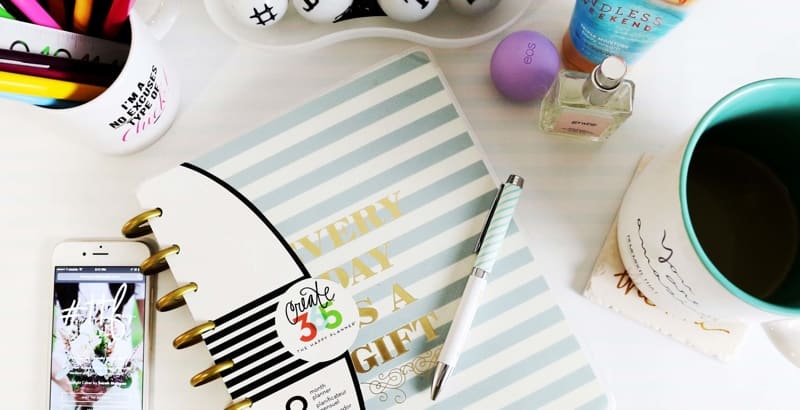
When I first learned more about my personality type (INFP) and how my brain receives and processes information, my mind was officially blown.
Seeing the big picture has always been one of my biggest strengths, so mind mapping is something that I’ve been doing for years without realizing that it had a name.
I doodled out mind maps in old diaries and notebooks, and eventually even used it for planning a college essay or two. I’ve always mind mapped on paper but have recently been experimenting with some free online mind mapping tools as well, and while I enjoy both methods, paper wins out for me.
What is Mind Mapping?
I define it as a tool for decluttering your brain. Some people would describe its function as more of a brainstorming or organizing tool. Really though, it’s both. It’s a highly effective method for getting thoughts onto paper in a way that makes sense for you.
Because the fine details of your mind mapping process and results are always unique, it’s pretty much universally helpful, whatever your personality type.
The amazing thing about mind mapping is that it uses both the creative and the logical sides of your brain, and brings them into harmony!
- When my brain starts to feel frenetic and I’m feeling overloaded with bits and pieces of information, I mind map so that I don’t forget things.
- When the copious conglomerate of things in my head feels like a dish of marbles that is overflowing and spilling everywhere, I mind map to organize my thoughts.
- When I feel that indicative tug of discontent in a particular area of my life (like parenting, wellness, or my writing), I mind map to make a plan.

(Note: I later re-wrote this mind map to have “wellness” as the center topic. This is an example of how I saw connections after the fact, like I mention below, and then scratched out the title at the top.)
How do you mind map?
Let’s assume we’re starting on paper. I think it’s best to start there to get a feel for the flow of mind mapping without having to mess around with (or get distracted by!) technology.
- Start in the middle of your paper and write your topic, and circle it.
- Then, without thinking too hard or deeply – start branching out.
- Add categories and sub-categories as you go, mapping everything out.
- Use the page freely – it doesn’t have to be perfectly neat and tidy!
- Don’t worry too much about putting things in the exact correct position – as you go on, patterns will begin to emerge and sequential thoughts will become apparent.
- You can erase and adjust lines and bubbles as you go. (I recommend using pencil, or just being okay with scribble marks.)
- I will sometimes even do a mind map as a rough draft, then re-draw it when I have my thoughts collected. These are the ones that I keep referring back to for months as I work on certain things. (Like my “wellness” mind map.)
Here’s a close-up of one of the branches in the wellness map that I made months ago in my bullet journal, and keep referring back to. (I highlight what I’m currently working on, then check it off when it’s done. You can see which item I’ve left until very last, ha!)
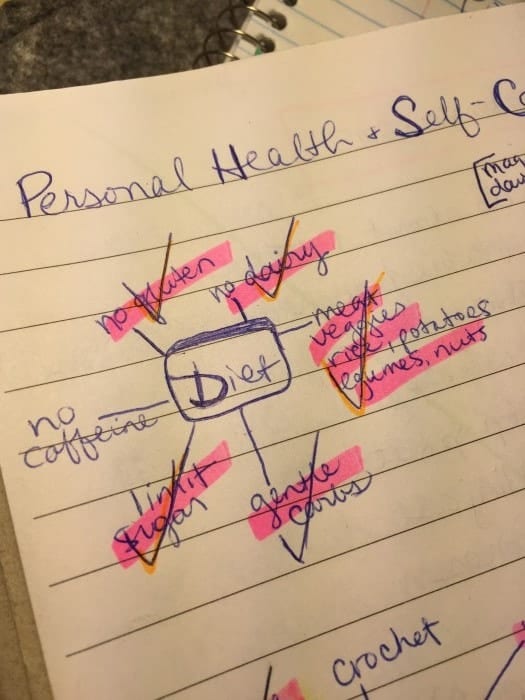
The most important thing is that if you have a thought in your mind related to your topic, be sure to write it down somewhere in the map so that it’s not crowding your mind anymore.
Every mind map is unique, but each one starts in the center, and radiates out like the branches of a tree. If you feel like you have more than one central topic on your mind, feel free to do more than one map!
Oftentimes, though, I find that when I get everything down on paper, I see things connecting that I hadn’t realized before.
For example: I mind mapped on the topic of “diet” and then I mind mapped on the topic of “home organization + routine”.
I subsequently realized that both of those topics, for me, fall under the umbrella of “overall wellness” because they contribute to a calm/peaceful mind, and a strong body – both of which are major components of my overall sense of wellness. And, there are other topics that I’d place under “wellness” too, so a new mind map with “wellness” at the centre was super helpful to me.
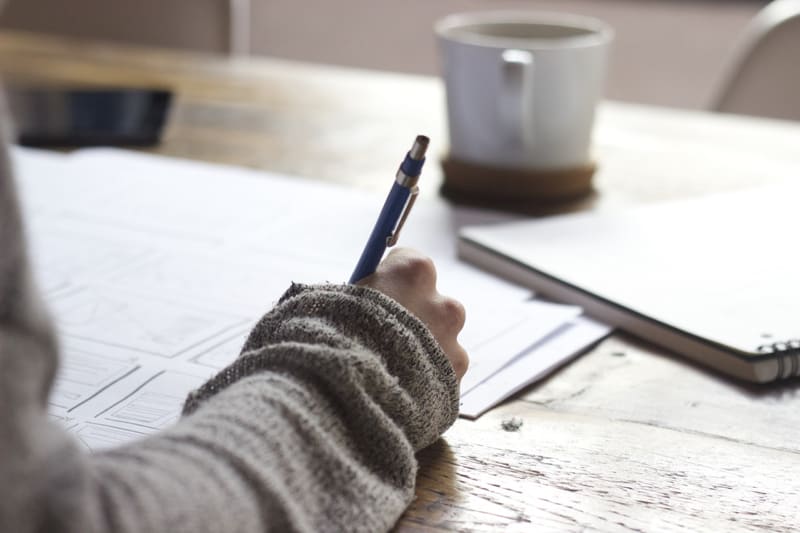
What Happens in Your Brain When You Do Mind Mapping?
As you create your mind map, the left and the right hemispheres of your brain are working in tandem. A 20th century scientific researcher named Roger Sperry (who later won a nobel prize for his neuroscience work) became famous for his research on the “left brain” and “right brain” concept.
Mind mapping uses a wide spectrum of brain functions, from both the left and right sides, including emotion management, imagination, lines and color, logic, memory, listing and numbers, words/expression, big picture thinking, and future planning.
Because of this, mind mapping is excellent exercise for the brain – a great bonus to an already helpful activity.
To amp up the effectiveness of your mind map, you can add illustrations. You don’t have to be an artist – any rudimentary sketch will do to assist your brain in mapping and in re-reading, later.
A coffee cup next to your “quit caffeine” bubble, or a stick figure next to the “yoga” bubble? Maybe a TV next to the “limit television” bubble. No need to go crazy with these if it ends up being more of a distraction than a help.
Whatever your style, getting your thoughts out onto paper in a non-linear free-style fashion will help declutter your brain so you can think more clearly.
Feeling Anxious at Night? Mind mapping is one tool that might help settle your thoughts.
This is the power of mind mapping: plotting out a framework on which to hang your thoughts. Just like the power of tidying and decluttering your house, mind mapping feels incredibly satisfying and freeing.
Have you ever tried mind mapping?
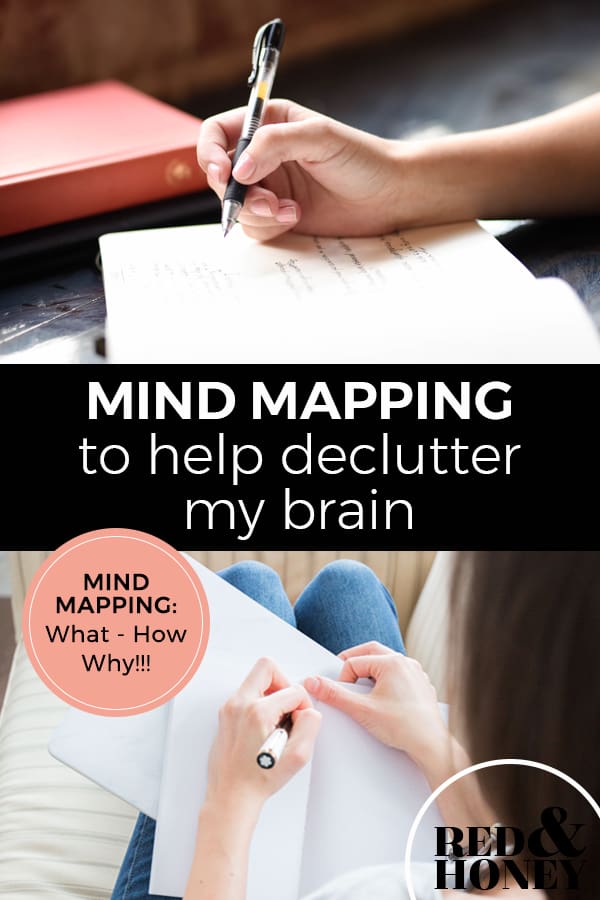

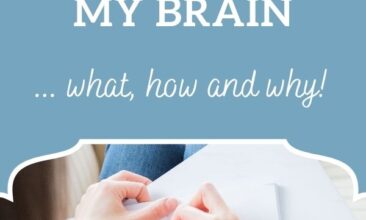
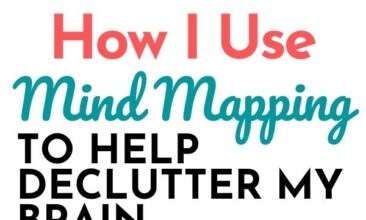
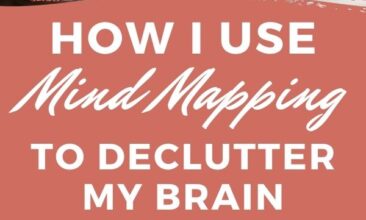
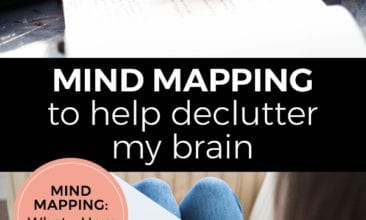










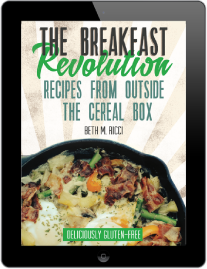

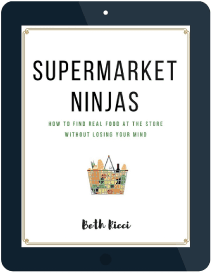







Chris
Extremely simple, but useful tactic for an disorganized individual like myself. I find it so difficult to unclutter my mind with so many “to-do’s” and information gathered throughout the day. Especially when you’re balancing hobbies, at home things, and work obligations and even relationships! Thanks for this.
Caitlyn
I’ve never heard of mind mapping but it seems exactly like what I need in my life. I often feel like I have a thousand thoughts running through my mind and it’s disorienting and frustrating. I used to use something like this when I was younger to plan essays though and I loved this strategy! I will definitely be trying out this soon!
Linda
“The Mind Map Book” by Tony Buzan is an excellent reference. I’ve had mine since it came out in 1993 and it’s well worn!
http://amzn.to/29WyPkQ
Louise
I taught high school English and used this webbing approach to help students generate ideas for writing and organizing. It is also a great way to just relax
Alice Sireno
What an awesome idea! I’m going to try this, asap. This is even more helpful than list making?
Kate
Oh my god! After years of having standard lists. I always felt like things were missing. You saved my life with this article. I’m forever thankful. I was too stressed to think of putting together all my thoughts like this! I’m 21 years old, owner of a non profit art gallery & a music venue, trying to help the world, bought my first investment home, trying to better my health, raising abandoned puppy and nursing a baby wild rabbit, trying to overcome PTSD & depression, trying to live healthier, have more social times for friends and family, and I am so busy! I was so overwhelmed until I started mind mapping. I will forever be grateful for your post! Thanks a million!
Liz
Wow Kate, you had a lot going on 6 months ago, there are some great achievements you’ve mentioned there at only age 21! Very inspiring, and I hope you’re doing ok with the PTSD xo
Luisa
Mind mapping is excellent! I use it to organize my mind for any school assignment, and divide it in categories.
However, I had never thought about using it to declutter my brain…..Amazing idea! Thank you so so much for sharing. I’ll definitely start doing it.
Jordan
Thank you so much for this wonderful article! I am so lucky to have come across it at a tough transitional time in my life (23 years old, living with parents, just graduated grad school, and consistently applying to jobs which I am unsure I will even enjoy-basically lots of thoughts and options and nowhere to organize my own desires and thoughts to hopefully manage my stress) and this mind mapping idea appears to be a perfect thing to try! I love writing and I think this would help me organize myself better so I can better understand what I want to do and what I need to do. I cannot wait to try this out! Thank you so much for this article and your mind mapping tips! I graduated with a masters in social work so I’m totally eating all this up, not only could it help me buy clients of mine as well! Yay! Thank you!!!
Kim
Thank you for this article. I’ve often created word document named “brain dump” to get everything out so that I can organize it into cohesive thoughts and ideas. This helps me before big meetings or if I have to communicate a heavy topic with someone. I never thought to do it like this – it makes it much easier to see the connections. Will definitely be trying this
AJ Paradis
Very cool. I needed this today. I’ve got a couple of down days and loads of projects. I need a map… and LOTS of caffeine! ;)- Thanks for this post.
Beth
Hope the mapping is helpful! Good luck with your projects! 🙂
Myasi Jackson
Extremely helpful. My mind was in sucha clutter and I refreshed my pinterest home screen and there this post was! Thank you!
Beth
Awesome! Love that you found this post at just the right time! Thanks for saying hello! 🙂
Joy
I’m enfp. I used to love mind mapping when I was in school, but had really forgotten about it until your post came up on my pinterest feed, and I’m so glad–as a working mom (i teach the performing arts to kids), step mom, and wife of a busy husband there is always too much going on in my brain. I can’t wait to put this tool back to use in my home and mothering life, spiritual and emotional life, and lesson planning. I also am fascinated by neuroscience and read about it for fun, so I can’t wait to read more of your blog. Thanks!
Beth
Neuroscience is a very small side passion of mine. “Brain and Behaviour” (taught by a neuroscientist) was my favourite class in 4 years of university! 🙂 Hope the mind mapping is helpful to you!
Megan
Love this idea! It’s interesting how different people put their thoughts onto paper differently. I’m more of a list-maker, personally, but I think it might be fun to try this more spatial activity and see how it goes.
I also like your method for focusing on one thing at a time and highlighting/ check marking it. I’m going to give it a try!
Beth
Thanks for reading, Megan! I think it’s definitely worth a try, even if you’re normally a list-maker. I think they serve different functions, really! 🙂
Elizabeth
Thank you for your article on mind mapping. I use it but I sometimes get so tied up in my thoughts it takes someone on my staff to pull it out of me. This is helpful. I just need to do it more often.
Beth
Sometimes my brain is such a jumbled mess that it takes several pages to get everything out. I hear ya! 🙂
Chantel
Thanks so much for this article! I’m an INFP too, and often just write things down or journal to sort through my thoughts. I haven’t tried mind mapping much, but will have to give it a go!
Beth
From one INFP to another – I bet you’ll love it! 🙂
Hannah
Your handwriting looks identical to mine! I’m in the twilight zone here. I love this idea of mind mapping. I think I learned it first from a book on creative writing. It seriously helped me learn to like writing. Good to see it applied to life planning and project-ing too!
Pam WhimsicalVintage
I love this idea and I can most definitely use it! Thanks so much and shared all around:)
LT Torgerson
I am very interested in the Upstream ecourse. I clicked the link but only found a message that the sale is over.
Our thought process is something that has been a subject of study for me for the past several years.
Beth
Hi LT, sorry about that! The sale is now over, but you can still purchase the course on its own from The Art of Simple, found here: http://theartofsimple.net/paddleupstream/
Dawne Forrester
Not even related but you are looking awesome!
Beth
Haha, thanks! 🙂
Carla
Where has this been all my life? I feel this could be life changing for me! This appeals to the visual part of my brain. I like that you referenced using it to write papers & for your daily life. It’s multi-functional! I love it!
Beth
It really is SO multi-purpose. Let me know how it goes for you! 🙂